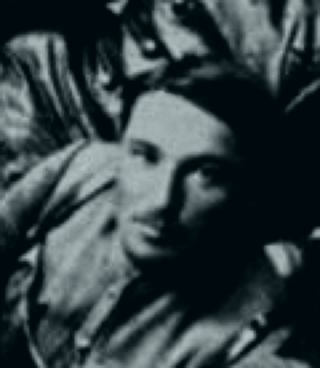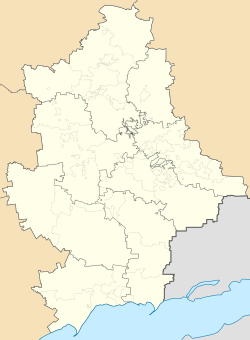
Donetsk Oblast, also referred to as Donechchyna, is an oblast in eastern Ukraine. It is Ukraine's most populous province, with around 4.1 million residents. Its administrative centre is Donetsk, though due to the ongoing Russo-Ukrainian War, the regional administration was moved to Kramatorsk. Historically, the region has been an important part of the Donbas region. From its creation in 1938 until November 1961, it bore the name Stalino Oblast, in honour of Joseph Stalin. As part of the de-Stalinization process, it was renamed after the Siversky Donets river, the main artery of Eastern Ukraine. Its population is estimated at 4,100,280.

Donetsk, formerly known as Aleksandrovka, Yuzivka, Stalin, and Stalino, is an industrial city in eastern Ukraine located on the Kalmius River in Donetsk Oblast, which is currently occupied by Russia as the capital of the Donetsk People's Republic. The population was estimated at 901,645 in the city core, with over 2 million in the metropolitan area (2011). According to the 2001 census, Donetsk was the fifth-largest city in Ukraine.

The Soviet Union introduced forced collectivization of its agricultural sector between 1928 and 1940 during the ascension of Joseph Stalin. It began during and was part of the first five-year plan. The policy aimed to integrate individual landholdings and labour into nominally collectively-controlled and openly or directly state-controlled farms: Kolkhozes and Sovkhozes accordingly. The Soviet leadership confidently expected that the replacement of individual peasant farms by collective ones would immediately increase the food supply for the urban population, the supply of raw materials for the processing industry, and agricultural exports via state-imposed quotas on individuals working on collective farms. Planners regarded collectivization as the solution to the crisis of agricultural distribution that had developed from 1927. This problem became more acute as the Soviet Union pressed ahead with its ambitious industrialization program, meaning that more food would be needed to keep up with urban demand.

The Donbas or Donbass is a historical, cultural, and economic region in eastern Ukraine. Parts of the Donbas are occupied by Russia as a result of the Russo-Ukrainian War.

The Holodomor, also known as the Ukrainian Famine, was a man-made famine in Soviet Ukraine from 1932 to 1933 that killed millions of Ukrainians. The Holodomor was part of the wider Soviet famine of 1930–1933 which affected the major grain-producing areas of the Soviet Union.

The Ukrainian Insurgent Army was a Ukrainian nationalist paramilitary and partisan formation founded by the Organisation of Ukrainian Nationalists on October 14, 1942. During World War II, it was engaged in guerrilla warfare against the Soviet Union, and both the Polish Underground State and Communist Poland.

Throughout Russian history famines, droughts and crop failures occurred on the territory of Russia, the Russian Empire and the USSR on more or less regular basis. From the beginning of the 11th to the end of the 16th century, on the territory of Russia for every century there were 8 crop failures, which were repeated every 13 years, sometimes causing prolonged famine in a significant territory. The causes of the famine were different, from natural and economic and political crises; for example, the Great Famine of 1931–1933, colloquially called the Holodomor, the cause of which was the collectivization policy in the USSR, which affected the territory of the Volga region in Russia, Ukraine and Kazakhstan.

Horlivka, also known as Gorlovka, is a city in Donetsk Oblast of Ukraine. Its population is 239,828.

Pokrovsk, formerly known as Krasnoarmiysk and Grishino, is a city and the administrative center of Pokrovsk Raion in Donetsk Oblast, Ukraine. Prior to 2020, it was incorporated as a city of oblast significance. Its population is approximately 60,127.

Huliaipole is a city in Polohy Raion, Zaporizhzhia Oblast, Ukraine. It is known as the birthplace of Ukrainian anarchist revolutionary Nestor Makhno. In January 2022, it had an estimated population of 12,786.

Avdiivka is a city in Donetsk Oblast, Ukraine. The city is located in the centre of the oblast, just north of the regional centre, Donetsk. The large Avdiivka Coke Plant is located in Avdiivka. The city had a population of 31,392 before the Russian invasion of Ukraine, but it was reported as 1,600 in October 2023, and then "just over 1,000", mostly living below ground level.

Borodianka is a rural settlement in Bucha Raion, Kyiv Oblast, Ukraine. It hosts the administration of Borodianka settlement hromada, one of the hromadas of Ukraine. Population: 13,832. According to the 2001 census, its population was 12,535.

The Soviet famine of 1930–1933 was a famine in the major grain-producing areas of the Soviet Union, including Ukraine and different parts of Russia, including Kazakhstan, Northern Caucasus, Kuban Region, Volga Region, the South Urals, and West Siberia. Major causes include: the forced collectivization of agriculture as a part of the First Five-Year Plan and forced grain procurement from farmers. These factors in conjunction with a massive investment in heavy industry decreased the agricultural workforce. Estimates conclude that 5.7 to 8.7 million people died of hunger across the Soviet Union.

In 1932–1933, a man-made famine, known as the Holodomor, killed 3.3–5 million people in the Ukrainian Soviet Socialist Republic, included in a total of 5.5–8.7 million killed by the broader Soviet famine of 1930–1933. At least 3.3 million ethnic Ukrainians died as a result of the famine in the USSR. Scholars debate whether there was an intent to starve millions of Ukrainians to death or not.

The causes of the Holodomor, which was a famine in Soviet Ukraine during 1932 and 1933, resulted in the death of around 3–5 million people. The factors and causes of the famine are the subject of scholarly and political debate, which include the Holodomor genocide question. Soviet historians, Stephen Wheatcroft and J. Arch Getty believe the famine was the unintended consequence of problems arising from Soviet agricultural collectivization which were designed to accelerate the program of industrialization in the Soviet Union under Joseph Stalin. Other academics conclude policies were intentionally designed to cause the famine. Some scholars and political leaders claim that the famine may be classified as a genocide under the definition of genocide that entered international law with the 1948 Genocide Convention.
The Soviet famine of 1946–1947 was a major famine in the Soviet Union that lasted from mid-1946 to the winter of 1947 to 1948.

Blacklisting, or the system of the chorna doshka synonymous with a "board of infamy", was one of the elements of agitation-propaganda in the Soviet Union, and especially Ukraine and the Kuban region in the 1930s, and is considered as one of the instruments of the Holodomor. Blacklisting was also used in Soviet Kazakhstan. Eventually it transformed into a means of repression of peasants.

Zatyshshia is a rural settlement in Rozdilna Raion of Odesa Oblast in Ukraine. It hosts the administration of Zatyshshia settlement hromada, one of the hromadas of Ukraine. Population: 3,488

Panteleimon "Panteley" Fyodorovich Belochub, , was a Ukrainian soldier best known as one of the commanders of the Revolutionary Insurgent Army of Ukraine, a major belligerent force during the Russian Civil Wars of 1917 – 1921.
Marianske is a village located in Kryvyi Rih Raion of Dnipropetrovsk Oblast. It belongs to Zelenodolsk urban hromada, one of the hromadas of Ukraine. It has a total population of 4183 people.
















